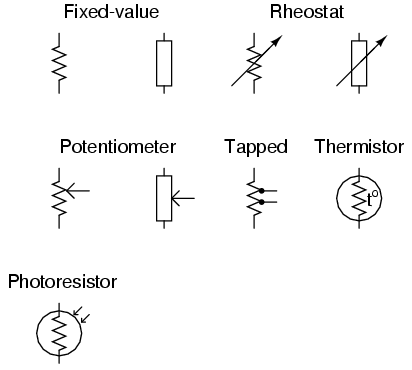Basic Schematic Symbols - PatternAgents/Electronics_One_Workshop GitHub Wiki
-
As we mentioned, the Schematic Diagram shows us how the circuit is put together, and where the electrons can travel, just like the Route Map for our Bus.
-
The (most) basic Schematic Diagram (shown below), depicts a Voltage {V} being applied across a Resistor {R}, causing a direct current {I} to flow from the positive (+) terminal through the Resistor {R} and to the negative (-) terminal. Just think of it as a Route Map with only one Bus and one Station (the Resistor {R}).

- There are several different types of Resistors, for example fixed value resistors, or variable value resistors (sometimes called Rheostats or Potentiometers), or resistors that change their value based on heat (called Thermistors ) or light (called Photoresistors ). Below we show some of the schematic symbols for those different type of resistors.

-
If you have ever used a light dimmer, you have used a variable value resistor to control the lamp brightness. Both Rheostats and Potentiometers are "variable-value" resistors, so what is the difference between them, can you tell? (Hint: A Potentiometer can be wired to be a Rheostat)
-
Why use a Schematic Symbol in place of an actual resistor ? Because it is much easier for most engineers to draw a Schematic Symbol, than it is to draw a picture of an actual resistor. So what do actual resistors look like? Here are an assortment that you can buy at distributors like Digikey

Above you can see several of the different types of "fixed-value" resistors, and they all use the same basic "fixed-value" schematic symbol. So how do we tell them apart? By their manufacturers part number, which will be unique to each component type and value at each manufacturer.
The unit of measurement of electrical resistance is called the "Ohm" and in one of my favorite little jokes in electronics, the inverse of electrical resistance is conductance, where conductance is the measurement of how well something passes electricity though it. The unit of measurement of conductance is known as the "Mho" (Yo! it's pronounced "Mo!"), which is "Ohm" spelled backwards. Who says engineers don't have a sense of humor...
Next ->
